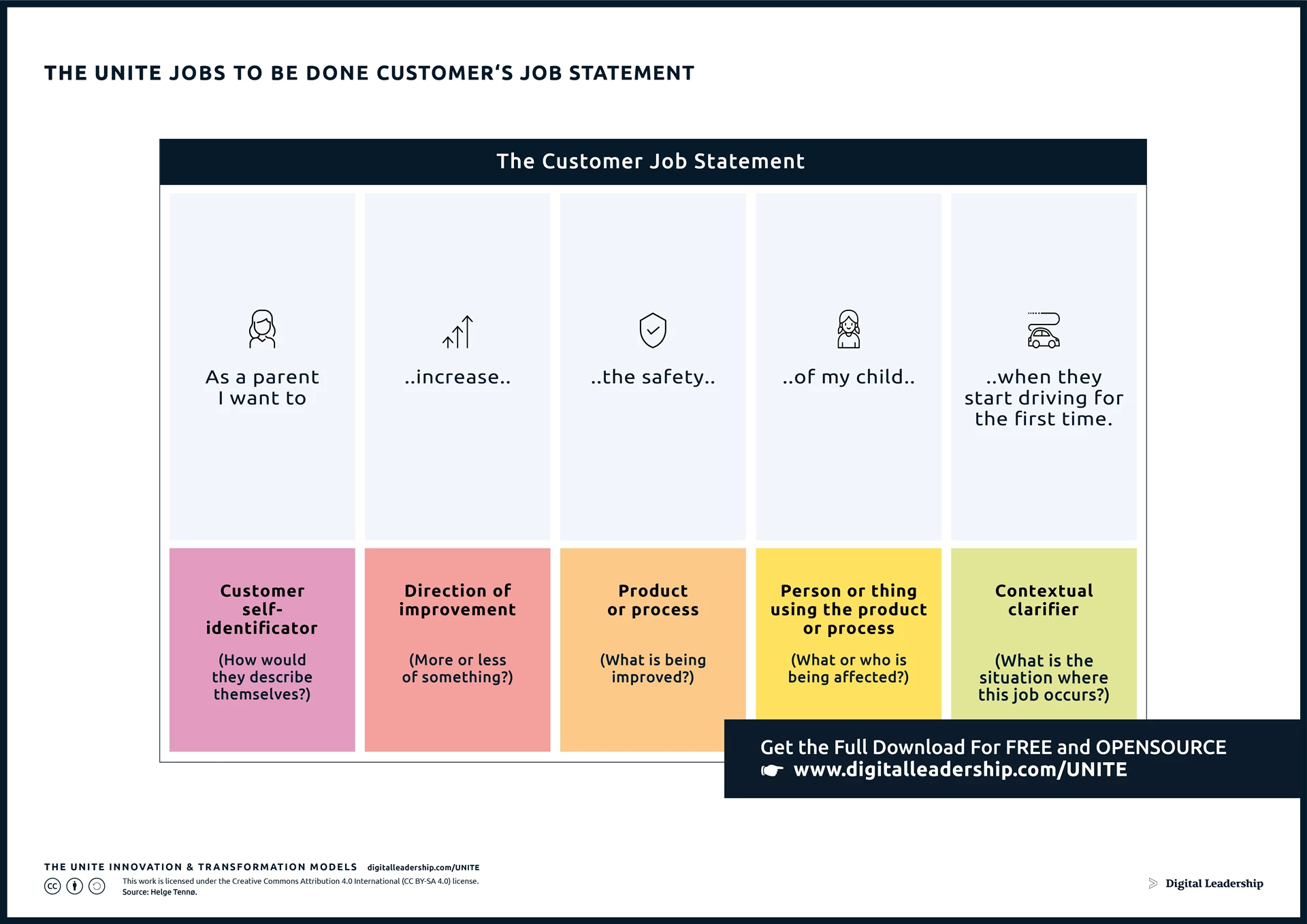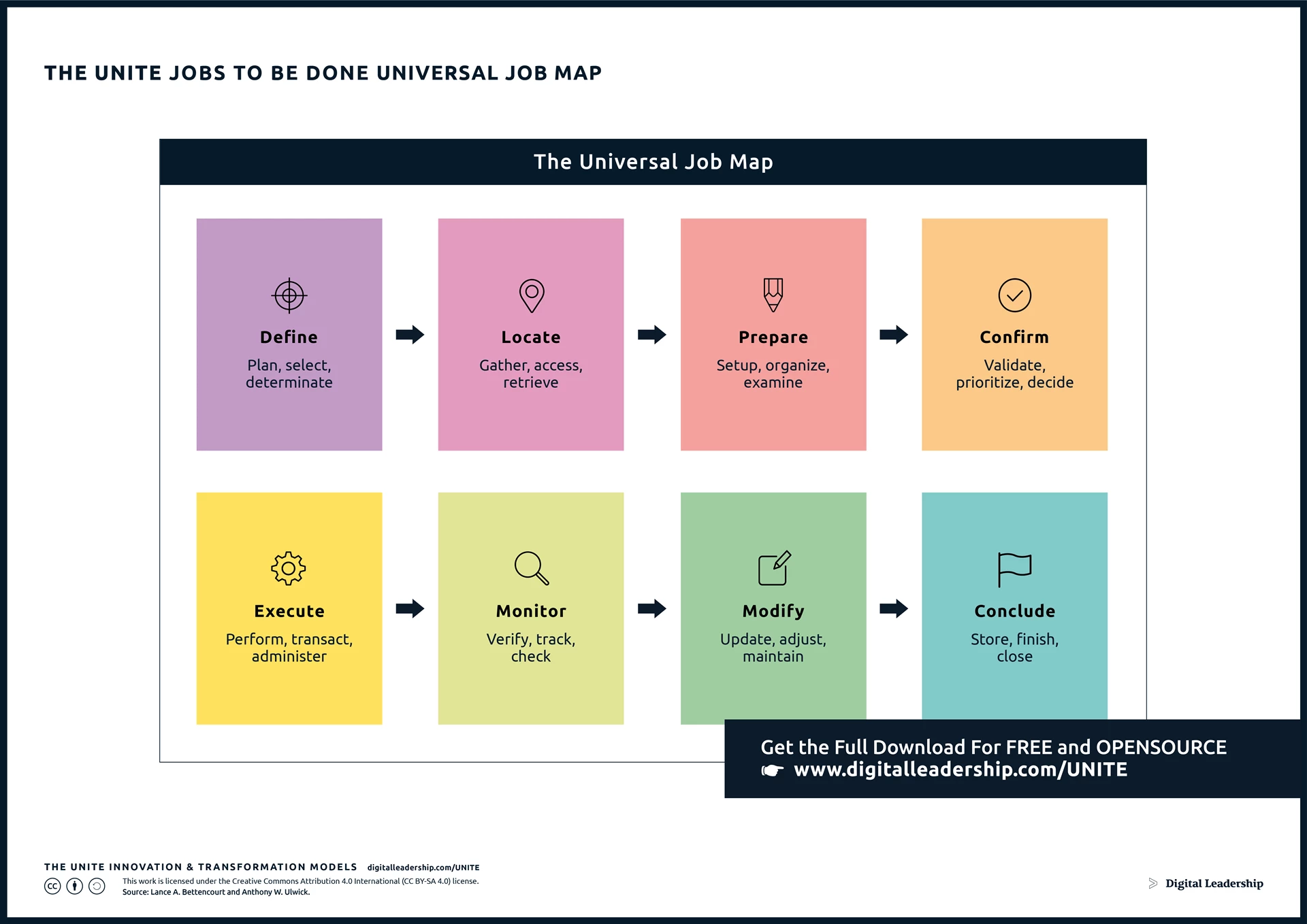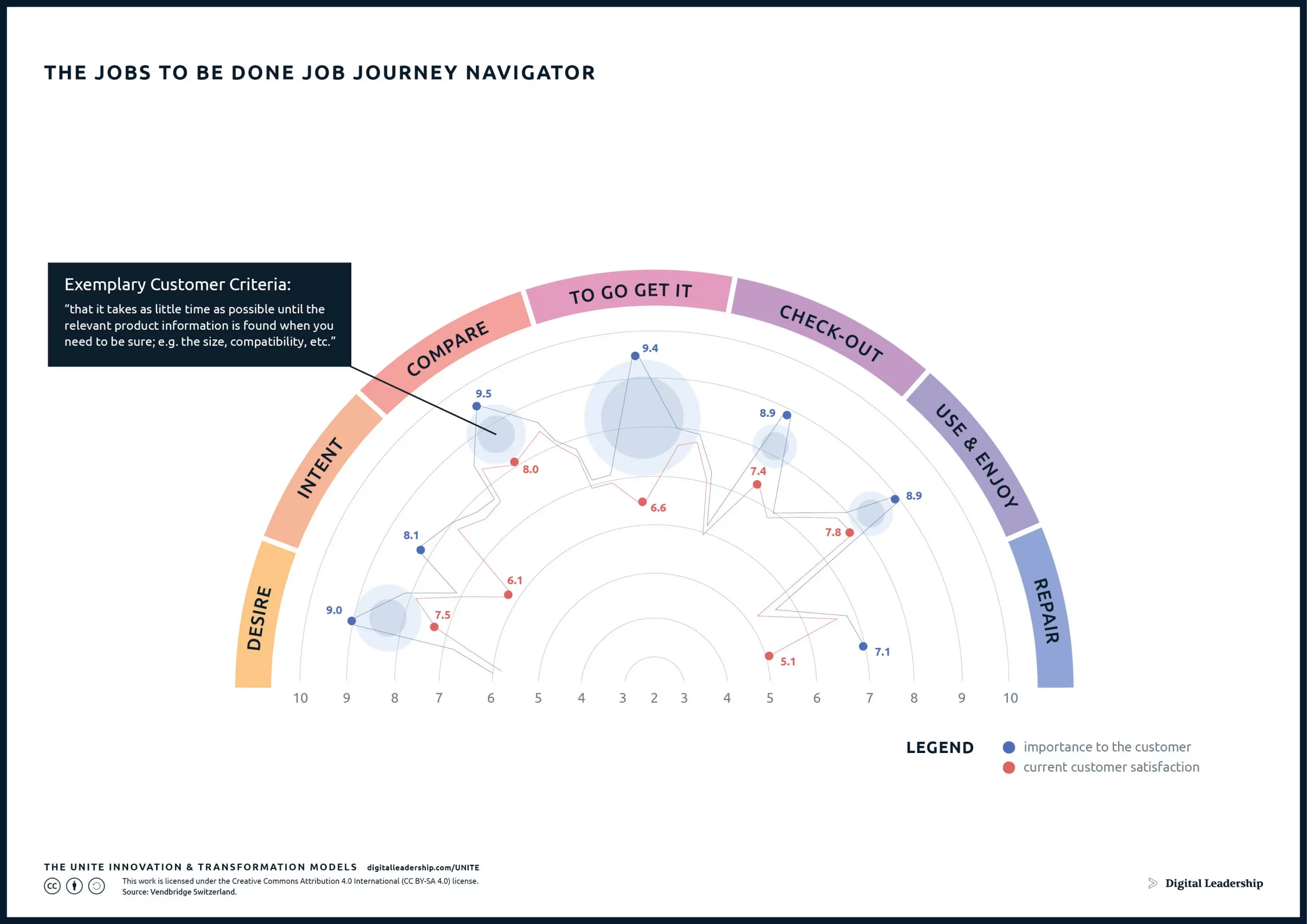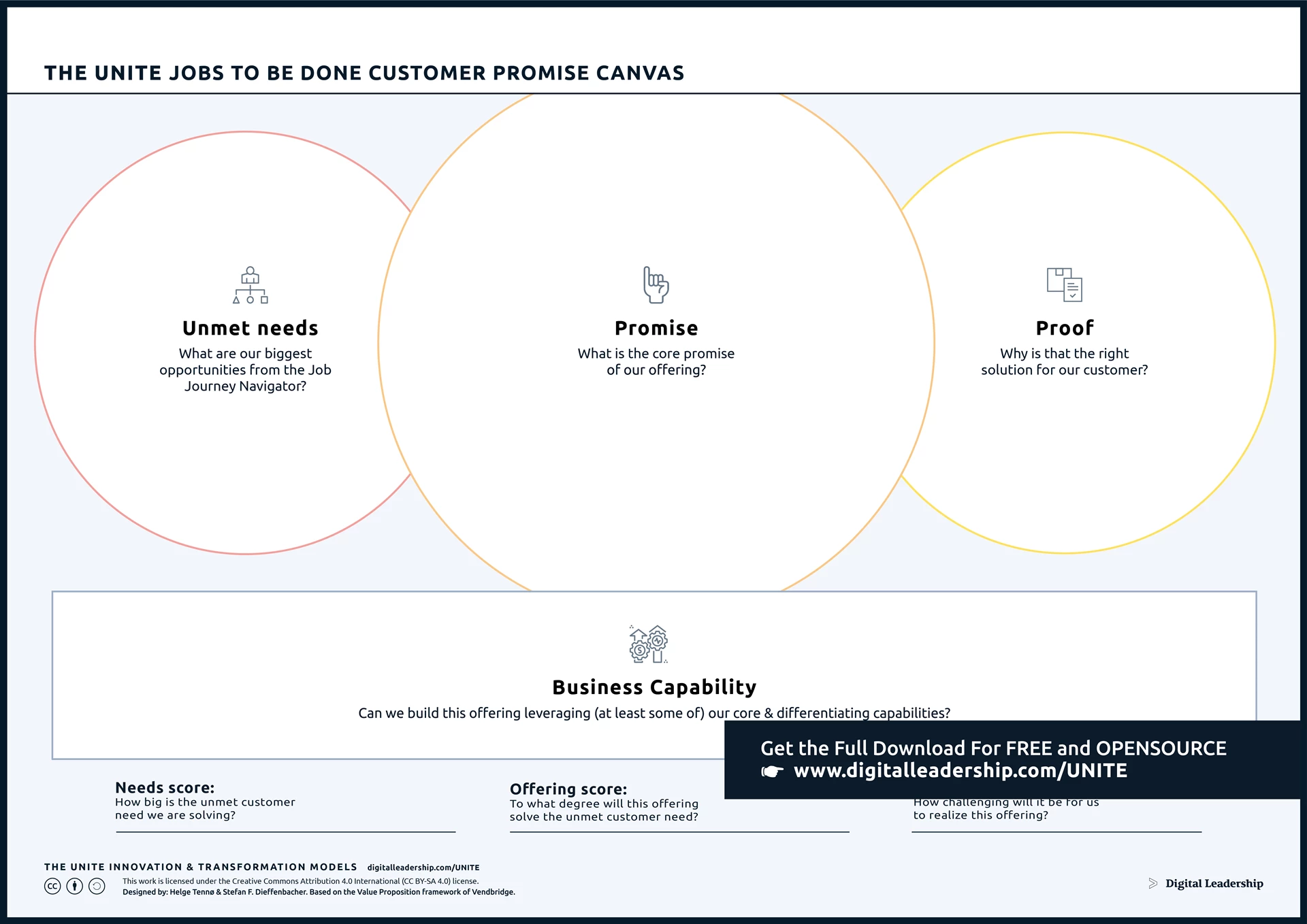Jobs to Be Done Framework in Product Management and Development

Implementing Jobs to be Done (JTBD) with an effective digital transformation strategy and innovation strategy becomes pivotal in Product Management and development. It emerges as a driving force, not just a phase within the product management process. The comprehension and resolution of Jobs to be Done stand at the forefront, underscoring their significance in orchestrating effective digital transformation and fostering innovation in product management and development within the broader business strategy.
Digital Leadership stands as a catalyst for positive change guiding organizations through disruptive change by leveraging emerging technologies and innovative digital business models and effortlessly incorporating Jobs to be Done principles seamlessly into its digital transformation Consulting and Product Development Consulting services. Our methodology involves deciphering essential customer jobs and guaranteeing a well-aligned digital transformation strategy that caters to market requirements. As an initial step to assist businesses in selecting tailored services that align with their specific needs and objectives for innovation, we offer an Innovation Blueprint to evaluate current innovation practices.
Understanding Jobs to be Done Theory
Jobs to be Done Theory is a framework that focuses on understanding underserved customer needs and motivations by looking at the “jobs” or tasks that customers are trying to accomplish in their lives. Instead of just analyzing features or demographics, JTBD delves into the functional, emotional, and social dimensions of customers’ goals.
According to the Jobs-to-be-Done Theory, the value of a product as a platform in a particular space is determined by its ability to assist customers in accomplishing various tasks. For instance, the Swiss Army knife serves multiple purposes, enabling customers to fulfil dozens of jobs, while the smartphone is instrumental in addressing a multitude of tasks, reaching into the thousands.
Much more about Jobs to be done and other approaches to innovation strategy you will find in our brand-new FREE book “How to Create Innovation” Register for the download now!
Implementing the Jobs to be Done (JTBD) theory in product management and development is important as it shifts the focus from merely creating products to addressing the fundamental needs and goals of customers. By understanding the specific jobs that customers are trying to accomplish, businesses can tailor their products to meet those needs effectively.
Jobs to be Done in Product Management
Jobs-to-be-Done (JTBD) theory is a crucial concept in product management that revolves around the idea that customers “hire” a product or service to fulfill a specific job or task in their lives. This framework focuses on understanding the underlying needs and motivations of customers, emphasizing that people don’t buy products; they hire them to accomplish a particular job.
In product management, JTBD plays a significant role in shaping product development strategies. Here’s how:
- Understanding Customer Needs: JTBD shifts the perspective from features and functionalities to customer-centricity. It helps product managers delve into the core needs and challenges customers face in various situations.
- Differentiation: By identifying the specific jobs customers are trying to get done, product managers can create products that stand out in the market. This differentiation is based on addressing real customer needs rather than perceived preferences.
- Product Innovation: JTBD encourages innovation by focusing on solving real problems. It guides product teams to innovate in ways that directly impact the customer’s ability to achieve their goals, leading to more meaningful and successful products.
- Market Alignment: Products aligned with the Jobs-to-be-Done framework are more likely to resonate with the target market. Understanding the jobs customers are hiring the product for enables better market positioning and messaging.
- User Stories vs. JTBD: While user stories describe features from the user’s perspective, JTBD goes deeper into the underlying motivations. It provides a broader context, helping product managers make informed decisions about what features to prioritize.
- Product Adoption: Applying JTBD in product management involves not just creating the product but ensuring its adoption. This includes onboarding strategies, aligning features with identified jobs, and enhancing the overall user experience.
- Continuous Improvement: JTBD isn’t a one-time analysis. It involves an ongoing process of understanding evolving customer needs, adapting products to address new jobs, and ensuring that the product continues to provide value over time.
How To Apply Jobs to be Done Framework to Product Management
Step 1: Formulating the JTBD Statement in Product Management
The initial step in crafting the Job to Be Done (JTBD) statement involves a two-step process focused on creating a succinct and customer-centric expression that captures the essence of the user’s need. Crafting the JTBD statement begins by formulating a concise and customer-centric statement in the customer’s voice. This structured sentence format encompasses the user’s improvement direction, the specific aspect to be improved, the entity affected, and a contextual clarifier.
For example: “As a product manager, I want to enhance collaboration in the ideation phase to ensure efficient and innovative product development.”
The UNITE JTBD Customer’s Job Statement Model is a reliable framework that ensures the creation of clear, insightful, and solution-agnostic statements. These statements play a pivotal role in the Jobs to Be Done Framework, aligning organizational strategies with authentic customer needs. This process fosters a profound understanding of an effective JTBD process, particularly in the realm of product management.

Designed by: Digital Leadership AG – Source: Helge Tennø.
Your download is now available!
You can now access the complete JTBD Customer’s Job Statement Package, including a full presentation, related models and instructions for use.
Step 2: Develop a Job Map in Product Management
In the Jobs to Be Done (JTBD) framework, the development of a Jobs to Be Done Journey Map is a crucial step in understanding and addressing user needs in product management. This job mapping process outlines the various steps and tasks that users undertake to accomplish a specific job, providing valuable insights into user behavior and requirements.
The Jobs to Be Done Journey Map utilizes the eight steps of the Job Mapping process to delineate the smaller tasks and activities users perform to fulfill their job in the realm of product management. This comprehensive tool offers a holistic view of the user journey, facilitating a deep understanding of their interactions and assisting in the design of solutions that align with their goals and expectations.
Incorporating “The UNITE Jobs to Be Done Universal Map” Model enhances this step, providing a visual representation that ensures a comprehensive understanding of the customer journey in the context of product management. This approach helps businesses align their strategies with identified jobs effectively.

Designed by: Digital Leadership AG – Source: Lance A. Bettencourt and Anthony W. Ulwick.
Your download is now available!
You can now access the complete Jobs to be Done Universal Map Package, including a full presentation, related models and instructions for use.
The Job Map involves outlining the smaller tasks and activities that customers undertake to accomplish their job. This is a collaborative process where the team gathers to brainstorm and categorize tasks into eight steps. The Universal Job Map comprises the following steps:
- Define and plan: The customer consciously or subconsciously creates an initial plan for their approach.
- Locate the input needed: Identifying and locating information necessary for decision-making.
- Prepare: Organizing information, filtering, qualifying, and making decisions.
- Confirm and validate: Making decisions and validating them.
- Execute: Performing the action or procedure resulting from the decision.
- Monitor: Monitoring the effects and outcomes of the decision.
- Modify: Assessing the decision based on new information and continuously monitoring or improving.
- Conclude: Concluding the journey, taking stock, and learning from the experience.
Step 3: Identifying Customer Jobs through interviews
- User Qualitative Interviews and Observations: Direct interaction offers valuable qualitative data.
- Surveys and Questionnaires: Structured tools quantify user jobs from a diverse user base.
- Data Analysis from User Interactions: Analyzing User Behaviour Unveils Implicit Jobs.
- Social Listening and Online Forums: Monitoring discussions provides insights from natural conversations.
The UNITE Jobs-to-be-Done template is recommended for defining Customer Criteria, providing a structured approach to gathering essential information for the product development process. The methodology encourages a holistic understanding of customer needs and preferences, ensuring that products align closely with the jobs customers are trying to get done.

Designed by: Digital Leadership AG – Source: Strategyn
Your download is now available!
You can now access the complete Jobs to Be Done Template for Defining Customer Criteria Package, including a full presentation, related models and instructions for use.
Step 4: Align Jobs to be Done with Product Features:
In product management, a crucial step after identifying jobs-to-be-done is aligning them with product features. This involves mapping each job to existing or planned features and assessing how well the product addresses them. The process includes evaluating strengths and weaknesses, incorporating user feedback, and prioritizing features based on job relevance. Innovative exploration, usability testing, and iterative development refine the alignment. Cross-functional collaboration ensures team synchronization, while monitoring tools track feature performance. A continuous feedback loop incorporates user insights for ongoing enhancements, enhancing the user experience and positioning the product as a dynamic solution in the market.
Step 5: Identifying Competitors
To gain a competitive edge in product management, conducting a thorough analysis of competitors is indispensable. Utilize established competitor analysis frameworks, ensuring a comprehensive assessment of strengths and weaknesses. Dive into user feedback on competitor products, extracting valuable insights to inform your product strategy. Implement benchmarking studies, comparing the performance of your product against competitors to identify areas for improvement. Stay abreast of industry trends through continuous industry landscape research, enabling your team to adapt strategies based on evolving market dynamics. This multifaceted approach to competitor identification equips your product management efforts with crucial insights for strategic decision-making and sustained success.
Step 6: Big Opportunities Identification
In the Jobs to be Done (JTBD) methodology, identifying big opportunities is a pivotal step that shapes the direction of product development. This phase involves translating qualitative insights gained from customer interactions into actionable opportunities.
- Evaluate and identify potential opportunities for product improvements or new features based on customer insights and pain points.
- Explore areas where your product can better align with the identified jobs.
Leveraging tools like the Job Journey Navigator, such as the one provided by Vendbridge, proves invaluable not only in product management but also in product development. This tool meticulously maps out each Customer Criterion, aligning it with the earlier established Job Map. The visualization serves as a guiding compass for the team, aiding in the seamless identification of substantial opportunities. This, in turn, streamlines the prioritization process, paving the way for envisioning potential solutions in both product management and product development spheres.

Designed by: Digital Leadership AG – Source: Vendbridge Switzerland.
Your download is now available!
You can now access the complete Jobs to Be Done Journey Navigator Package, including a full presentation, related models and instructions for use.
Step 7: Test and Iterate:
Continuously subject your product to scrutiny through the JTBD framework. Collect valuable feedback from users and iteratively refine features to more closely align with evolving customer needs.
Step 8: Designing Solutions for Desired Outcomes
This step is a pivotal stage that involves cross-functional collaboration and creative design thinking to address identified opportunities. Engaging in collaborative design thinking sessions fosters the generation of innovative solutions, emphasizing user-centricity. Rapid prototyping and testing enable iterative refinement based on user feedback, ensuring that the proposed solutions align closely with user needs.
For product development, consider adapting the UNITE Customer Promise Canvas into a team competition, encouraging individuals to create competing promises for the same unmet need. This approach, using the canvas’s scoring mechanism, facilitates the identification of the most effective solutions and aligns product development efforts with customer expectations. The canvas becomes a valuable tool for filtering opportunities and instilling confidence in the selected promises.

Designed by: Helge Tennø & Stefan F. Dieffenbacher. Based on the Value Proposition framework of Vendbridge
Your download is now available!
You can now access the complete Jobs to Be Done Customer Promise Canvas Package, including a full presentation, related models and instructions for use.
Step 9: Monitoring, Analytics, and Feedback Loop Closure:
Implement robust monitoring and analytics tools, such as user behavior tracking and performance metrics analysis, to continuously assess how well your product aligns with the identified jobs. Set up key performance indicators (KPIs) related to the effectiveness of your product in fulfilling customer needs. Additionally, establish feedback mechanisms to gather insights from users post-implementation. This iterative process allows for refinement of product features based on real-time data, ensuring continuous alignment with evolving customer expectations and industry trends. Regularly analyze collected data to identify areas for improvement and innovation in your product development strategy.
Benefits and Drawbacks of Applying JTBD in Product Management
Implementing the Jobs-to-be-Done (JTBD) framework in product management comes with various advantages and challenges. Understanding these aspects is crucial for organizations aiming to leverage JTBD effectively.
| Benefits of JTBD in Product Management | Drawbacks of JTBD in Product Management |
|---|---|
| Customer-Centric Innovation: JTBD places a strong emphasis on understanding customer needs and motivations. This customer-centric approach fosters innovation that directly aligns with what customers want to achieve. | Complex Implementation: The JTBD framework requires a comprehensive understanding of customer behavior and may involve complex processes such as job mapping and analysis. Implementation may be challenging without the right expertise |
| Holistic Product Development: By identifying the complete spectrum of jobs customers are trying to get done, organizations can develop more holistic products. This goes beyond addressing surface-level needs to understanding the deeper, functional, emotional, and social aspects of user requirements. | Data Collection Challenges: Gathering accurate and actionable data about customer jobs can be demanding. It may require extensive research, interviews, and analysis to uncover the nuanced aspects of customer needs. |
| Enhanced Product Adoption: Applying JTBD helps enhance product adoption by tailoring offerings to specific customer jobs. This targeted approach increases the likelihood of customers finding significant value in the product. | Resource Intensive: Implementing JTBD effectively may demand significant time and resources. Organizations need to commit to ongoing research, analysis, and adaptation to keep pace with evolving customer expectations. |
| Competitive Edge: A deep understanding of customer jobs provides a competitive edge. It allows organizations to differentiate their products by addressing unique and unmet needs, potentially outperforming competitors. | Integration with Existing Processes: Integrating JTBD into existing product management processes can be a significant undertaking. Ensuring alignment with other methodologies and frameworks is essential for seamless execution. |
Implementing the Jobs-to-be-Done (JTBD) framework in product management brings customer-centric innovation, holistic product development, enhanced product adoption, and a competitive edge. However, organizations must navigate challenges such as complex implementation, data collection difficulties, resource-intensive processes, and the need for integration with existing workflows. Careful consideration is essential to balance the benefits and drawbacks effectively.
Jobs to be Done Framework Importance for Product Managers
The Jobs-to-be-Done (JTBD) framework holds significant importance for Product Managers, providing a valuable lens through which they can understand, analyze, and enhance their products. Here are key reasons why the JTBD framework is crucial for Product Managers:
- User-Centric Focus: JTBD places a strong emphasis on understanding the underlying motivations and goals of users. This user-centric approach helps Product Managers move beyond feature-driven development to delivering solutions that genuinely meet users’ needs and expectations.
- Identifying Unmet Needs: By delving into the jobs that users are trying to accomplish, Product Managers can identify unmet needs or pain points. This insight is invaluable in guiding product development toward addressing critical gaps in the market, leading to more innovative and impactful solutions.
- Enhanced Decision-Making: JTBD provides a structured framework for decision-making. Product Managers can use this approach to prioritize features, enhancements, and strategic initiatives based on their alignment with the core jobs that users are hiring the product to do. This ensures that resources are allocated to areas with the highest impact.
- Competitive Advantage: Understanding the jobs customers are trying to get done allows Product Managers to differentiate their products in the market. By tailoring the user experience and features to address specific jobs better than competitors, products can stand out and gain a competitive edge.
- Informed Product Roadmaps: JTBD guides the creation of product roadmaps based on user needs and desired outcomes. This strategic alignment ensures that the product evolves in a direction that resonates with users, fostering long-term loyalty and satisfaction.
- Effective Communication: The JTBD framework provides a common language for cross-functional teams. Product Managers can effectively communicate user needs, priorities, and the rationale behind product decisions, fostering better collaboration among teams involved in product development.
- Continuous Improvement: JTBD encourages a mindset of continuous improvement. Product Managers can leverage insights gained from understanding user jobs to iterate on existing features, test new ideas, and ensure that the product remains relevant in a dynamic market landscape.
- Risk Mitigation: By focusing on the jobs users need to accomplish, Product Managers can mitigate the risk of investing resources in features or enhancements that do not align with actual user needs. This leads to more informed and calculated decision-making.
Conclusion
In summary, integrating Jobs-to-be-Done (JTBD) theory into product management is a transformative strategy for businesses seeking digital leadership. Understanding that products fulfill specific customer jobs provides a profound framework for creating solutions that genuinely meet user needs. This approach involves strategic implementation, distinguishing JTBD from user stories, and practical steps like identifying customer jobs, mapping them to product features, and iterating based on user feedback.
Recent Posts

Business Level Strategy Examples, Types, Definition and Implementing Steps For Successful Strategy
Social ShareIn the business environment, the choice of an effective strategy can...
View Full article
Radical Innovation Meaning, Examples and Characteristics
Social ShareRadical innovation is a main type of innoavtion that involves the...
View Full article





























 Book How to Create Innovation
Book How to Create Innovation